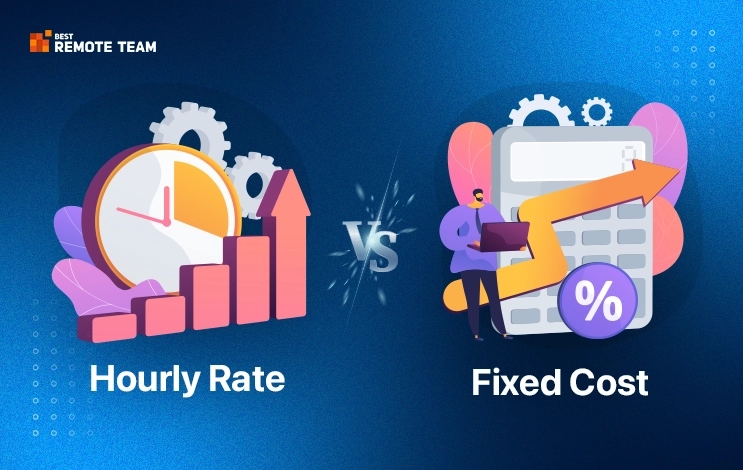What is Fixed Cost?
Fixed cost pricing establishes a project’s expected price before any work starts. Projects with a well-defined scope and unambiguous, thorough requirements greatly benefit this paradigm.
Once the price is decided upon, it stays fixed independent of the real-time work needed to do the job. This method gives customers budget certainty to make plans free from concern about unanticipated expenses.
For customers who must strictly follow a budget and would rather know the whole cost up advance, fixed-cost pricing is helpful. The financial side of project management is streamlined by removing the need for continuous cost analysis and approvals.
It also guarantees that from the beginning, the deliverables of the project are understood by the customer and the service provider in unison. However, this paradigm may be rigid, as any modification to the project scope might call for renegotiation and more expenses.
Key Benefits of Fixed Cost
1) Budget Certainty
Budget predictability is among the most important benefits of a fixed cost strategy. Knowing the upfront cost of app development helps companies properly allocate their money without concern about unanticipated expenses.
2) Simple Decision-Making
Under a fixed-cost approach, all cost-related choices are decided at the project’s start. This simplifies the development process by lowering the need for continuous budget debates and approvals.
3) Clear Deliverables
The precise knowledge of the deliverables results from defining the scope and requirements at first. This clarity helps the customer and the mobile app development firm remain in line throughout the project.
Disadvantages of Fixed Cost
1) Restricted adaptability
Fixed-cost projects may be rigid. Any modifications to the scope or criteria after the project began might call for renegotiation and extra expenses.
2) Possibility of Oversawment
Developers could incorporate a buffer in the fixed cost to help reduce the possibility of underestimating the project scope. This might lead to an initial cost more than if the job were invoiced hourly.
3) Scope Creeping
Fixed-cost projects risk scope creep, in which case further features or requirements are added without commensurate changes in cost or schedule if improperly controlled.
When to Choose Fixed Cost?
Expected Budget
Companies with tight budgets or those who value financial consistency might use a fixed-cost approach. It offers an apparent financial commitment right from the beginning.
Specified Area of Influence
Projects appropriate for a fixed cost model are those with correctly stated needs and a clear goal. It guarantees that the deliverables of the project are known to both sides in mutual agreement.
What is an Hourly Rate?
Hourly rate defines developers will only be paid for the number of hours they spent working on development project. Under an hourly rate price system, the customer is billed depending on the actual project time. Projects with changing needs or those where the scope is not entirely clear initially find frequent use for this paradigm.
Key Benefits of Hourly Rate
1) Adaptation
Hourly rate projects provide more freedom to fit changing scopes or need. For complicated or creative tasks where the outcome may not be understood at first, this helps significantly.
2) Transparency
Clients may monitor precisely how much time is being spent on every facet of the project using an hourly fee approach. More communication and trust may result from this openness.
3) Economical Cost Effectiveness
An hourly charge is more affordable for projects needing regular changes or where the scope will change. Clients eliminate the need for buffering in pricing by paying only for the completed service.
Disadvantages of Hourly Rate
1) Budget Uncertainty
Budget unpredictability is one of the key negatives of an hourly rate approach. Estimating the cost of app development ahead might be difficult and could result in financial volatility.
2) Probability of Mismanagement
Hourly rate projects may suffer from inefficiencies or time mismanagement without thorough monitoring and management, increasing costs and extending longer timescales.
3) Administrative Load
Accurate hours tracking calls for administrative solid systems, which could complicate the project and increase administrative costs.
When to Choose Hourly Rate?
Dynamic Scope
Early-stage development projects or those with changing needs might profit from the adaptability of an hourly rate approach. It allows iterative development and corrections to be possible depending on the comments.
Detailed Tracking
Transparency of an hourly fee model may be helpful for clients who want a thorough understanding of how time and resources are used.
Hourly Rate vs. Fixed Cost: Which is Right for You?
1. Cost Forecasting
Fixed costs provide companies with great cost certainty, facilitating their budgeting and planning. Hourly Rates are expenses dependent on actual time spent; this offers less consistency.
2. Risk Management
Fixed cost shifts the risk to the developer as they are accountable for underestimating the project’s extent. The customer pays for real time spent, so depending on the complexity of the project, the risk is shared.
3. Scope Flexibility
Fixed Costs are less flexible as scope changes might call for renegotiation and more expenses. Whereas a highly flexible hourly rate enables alterations and adjustments free from significant contractual changes.
4. Efficiency Incentives
With Fixed Cost, dedicated developers are driven to optimize their profit margins within the specified price by working quickly. Whereas Hourly rates are compensated for the time spent, developers may not have the same drive to work well.
5. Administrative Effort
Fixed expenses establish scope and cost upfront, requiring less continuous administrative labor. Add to administrative chores by constantly recording and reporting hours spent.
Which One Should You Choose for the Next App Development Project?
Project scope, budget restrictions, flexibility needs, and risk tolerance all influence whether one chooses a fixed cost or hourly rate pricing strategy. These salient features will assist you in making decisions:
- A fixed cost model is best if your project has a clearly defined scope with clear deliverables and low opportunity for modification. It guarantees that your initial payments precisely cover what you are paying for. Projects like typical mobile app development, where the features and functions are specified, find great use for this architecture.
- Fixed cost models provide companies with tight budgets with the benefit of cost certainty. You may make realistic financial plans free from concern about unanticipated costs. Startups and small companies trying to properly control their app development cost particularly need this.
- Hourly rates are more appropriate if your project scope is expected to fluctuate or if you want revisions throughout development. It gives the adaptability to change priorities and criteria depending on fresh data or comments. This approach helps creative ideas or those in fast-changing sectors.
- An hourly rate model guarantees that the service provider is fairly paid for their time and work and lets one have more control over the direction and speed of the project. To prevent financial overruns, nonetheless, it calls for constant observation.
In the end, your organizational goals and the particular requirements of your project will determine whether an hourly rate or fixed cost best suits you. Careful evaluation of these elements will help you choose the pricing strategy most likely to support your project’s financial objectives and success.
Conclusion
The success of your app development project depends on your selecting the appropriate pricing strategy. At Best Remote Team, we offer the best app development services at a flexible pricing level that meets your expectations without compromising on development quality.
At Best Remote Team, you enjoy the benefits of bringing a dedicated team to the table that can turn any development concept into success. Contact us today and give a competitive edge to your development success.





